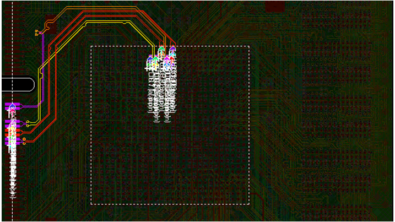Length matching for 10GHz links
For most busses, length-matching a group of signals to 5 mils is a bit of overkill. But, if length-matching to 5 mils is as easy for your layout personnel as length-matching to 100 mils, why not get the extra margin? However, for very fast serial links, length-matching the two sides of a differential pair is absolutely crucial. That is one of the key steps I discuss in my article “Ten Steps to Ten GigHertz“.
But length-matching the total length to a tight tolerance isn’t the only length-matching requirement. Of course, the two halves of a differential pair need to be tightly length-matched so that both halves of the signal arrive at the same time. But it is also important that the two halves of the signal travel together as well – in other words, the + and – signal should be in phase with one another throughout the route. That means at any given location, the trace lengths are matched. This is especially important at vias, where the matching of the signals is incredibly important to ensure that the signals pass through the vias in a purely differential mode, as this will limit the amount of energy radiated by the signals, as well as limit the amount of noise that the signals pick up. This is especially crucial for 10GHz signals where margins are very tight.
This type of length-matching can be achieved by using phase-matching routing, like that implemented in Xpedition VX. My colleague Charles discussed this the other day in his blog. Click here to take a look if you are interested.


